Healing from Trauma: Why Your Scars Are Symbols of Strength

When we talk about healing from trauma, many people assume it means forgetting. Pushing away the past. Burying the pain. But true healing doesn’t mean erasing the wounds we carry. It means learning to live with them. It means recognizing our emotional and psychological scars as part of our story — not as flaws to hide, but as reminders of everything we’ve survived. In therapy, this shift in mindset is often where the real transformation begins. What Trauma Really Is — And Why It Stays With Us Trauma doesn’t always come from a single, dramatic event. It can result from prolonged stress, emotional neglect, sudden loss, or even ongoing microaggressions. Whether you’re aware of the moment your trauma began or not, the effects are deeply real and personal. Emotionally, trauma can make us feel unsafe, disconnected, or numb. It can erode our sense of self and leave us hypervigilant, anxious, or depressed. Physically, it often manifests in fatigue, sleep disturbances, muscle tension, and chronic stress symptoms. You might not “see” your trauma the way you see a scar on your skin — but it lingers, often just beneath the surface. Why Healing Doesn’t Mean Forgetting Healing is not a destination where pain disappears. Instead, it’s an ongoing process of making peace with your past, learning to care for your inner world, and integrating your experiences into your life story. Forgetfulness is not strength — presence is. Avoidance may feel protective at first, but in time, it can isolate us from ourselves. The people who learn to sit with discomfort, face the truth of their past, and still choose growth are often the most resilient among us. Your scars — emotional, psychological, or physical — are evidence that you’ve been hurt and that you’ve healed. They are the bridges between survival and strength. Embracing Scars as Evidence of Strength So many people view their emotional wounds as something to be ashamed of. But in reality, scars are proof of healing. They say, “I made it through something hard. I came out the other side.” Shifting your perspective in this way is liberating. Instead of defining yourself by the pain you experienced, you begin to define yourself by the strength it took to endure it. You reframe your past not as a permanent injury, but as a source of power. This doesn’t mean glorifying trauma. It means reclaiming agency — recognizing that even in situations where you had no control, your choice to heal is still yours. Growth After Trauma Is Possible — Even Common It may surprise you to know that research shows many trauma survivors don’t just bounce back — they grow forward. This is called Post-Traumatic Growth (PTG), a concept supported by decades of psychological research. PTG describes the positive psychological changes that can occur as a result of struggling with traumatic experiences. These changes often include a deeper appreciation for life, stronger relationships, increased emotional resilience, spiritual development, and a newfound sense of personal strength. More than half of trauma survivors report experiencing some form of positive growth after adversity. While that doesn’t mean the trauma was “good,” it does show how capable we are of rebuilding something meaningful from our pain. Kintsugi and the Beauty of Imperfection In Japanese culture, there is an art form called Kintsugi, where broken pottery is repaired with gold. Instead of hiding the cracks, artisans fill them with shimmering lacquer, transforming the once-broken object into something more valuable and beautiful than before. The philosophy behind Kintsugi teaches us that our imperfections and scars are not blemishes — they are features of our uniqueness and proof of resilience. This metaphor resonates deeply with trauma survivors. What if your cracks — your wounds, your healing — were not just tolerated, but honored? What if your story, as it is, was already worthy? Across cultures, scars are often seen as symbols of strength and bravery. In some traditions, they mark rites of passage or life-defining courage. Embracing this view can empower you to see yourself not as damaged, but as forged through fire. Your Story Matters: Turning Scars Into Strength One of the most powerful ways to reclaim your trauma is by telling your story. Whether through journaling, speaking with a therapist, creating art, or simply talking with a trusted friend, expressing your journey can be healing in itself. Telling your story does three important things: It validates your experience. Naming what happened — and how it affected you — is a crucial step in moving through pain. It breaks isolation. So many survivors feel alone, but in truth, trauma is incredibly common. Sharing builds connection. It empowers others. When you speak your truth, you give others permission to do the same. Your story may be someone else’s survival guide. This doesn’t mean you have to share everything with everyone. But when you do speak, speak from your strength — not your shame. Therapy: A Safe Space to Heal and Integrate If you’re reading this and realizing you’ve buried pain, or that you’ve never given yourself permission to embrace your scars, therapy can be an invaluable space to begin that journey. In therapy, you’re not expected to have the answers. You’re simply invited to bring your whole self — the broken parts, the strong parts, the confused parts — and be seen. With the support of a therapist, you can begin to: Process difficult memories at your own pace. Reframe self-critical thoughts and internalized shame. Learn grounding techniques to handle anxiety and triggers. Build healthier relationships with yourself and others. Most importantly, therapy provides a relationship built on empathy, trust, and non-judgment. For many people, it becomes the first place where they feel safe enough to begin truly healing. Daily Practices for Embracing Your Scars While therapy can be a cornerstone of healing, there are also daily practices you can incorporate into your life to support your journey: 1. Self-CompassionTalk to yourself with the same kindness you would offer a dear friend. Replace harsh
Beat Stress: Your Brain Is Your BEST Weapon

Stress is the modern epidemic. It creeps into our lives through demanding work schedules, family obligations, financial pressures, and the constant digital noise that never lets us fully unplug. Yet, even though stress may feel like it’s taking over, you already possess the most powerful tool to fight it: your brain. The human brain is not just affected by stress — it’s also uniquely equipped to manage, heal from, and even grow stronger through it. With the right strategies and support, your brain can become your most valuable ally in reducing stress and living a more balanced, fulfilled life. Let’s dive into how stress works, how your brain responds, and what you can do — starting today — to take control. Understanding What Stress Really Does to You At its core, stress is your body’s way of responding to any kind of demand or threat. When you perceive danger — whether it’s a looming deadline or an actual physical threat — your nervous system springs into action. Your heart races, your muscles tense, your senses become sharper, and your brain gets flooded with cortisol and adrenaline. In short bursts, this response is helpful. It can boost your focus, sharpen your reflexes, and help you power through tough moments. But when stress becomes chronic — meaning it sticks around long after the threat is gone — it starts to wear down your mental and physical health. Long-term stress can shrink the hippocampus (the part of your brain responsible for memory and learning), increase the size and sensitivity of the amygdala (which processes fear and emotions), and reduce functioning in the prefrontal cortex (your brain’s control center for decision-making and rational thinking). That’s why chronic stress can leave you feeling foggy, irritable, and emotionally reactive — not to mention physically exhausted. The Brain’s Secret Superpower: Neuroplasticity Here’s the good news: your brain is incredibly adaptable. It’s wired for change. This process, called neuroplasticity, allows your brain to form new connections, strengthen healthy pathways, and even repair damage caused by stress over time. You’ve probably experienced this without realizing it — maybe you learned to stay calm under pressure after years in a high-stakes job, or you noticed how much easier it became to meditate or practice deep breathing the more you stuck with it. That’s your brain reprogramming itself. Even better? You don’t need to overhaul your life overnight. Small, consistent shifts in how you think and behave can trigger powerful transformations in how your brain handles stress. Training Your Brain to Think Differently About Stress Thoughts play a massive role in how we experience stress. The same situation can feel overwhelming or manageable depending on how we interpret it. This is where cognitive strategies come into play — particularly those used in Cognitive Behavioral Therapy (CBT). CBT helps you recognize negative thinking patterns and replace them with more helpful, realistic ones. For instance, if your first reaction to a mistake is “I’m such a failure,” CBT would guide you to challenge that thought: Is that true? Is there another way to see this? What would I say to a friend in this situation? Over time, this practice of re-framing becomes second nature. You stop catastrophizing and start responding from a calmer, more grounded place. Another powerful mental tool is mindfulness — the practice of bringing your full attention to the present moment. Instead of spiraling into “what if” scenarios about the future, mindfulness helps you anchor into what’s happening right now. Studies show that just a few minutes a day of mindfulness meditation can lower cortisol levels, improve emotional regulation, and boost focus. And don’t overlook the value of writing. Journaling helps your brain process experiences, track patterns, and make sense of emotions. It turns the swirling chaos in your head into something tangible you can reflect on and, ultimately, work through. Daily Habits That Build Stress Resilience Let’s shift from the brain to your body — because the two are deeply connected. Your physical habits can either fuel stress or help release it. Exercise is one of the most effective natural stress relievers. You don’t need to run marathons — even a 20-minute walk can calm your nervous system, release endorphins, and improve your mood. What you eat also matters. Diets high in sugar, caffeine, and processed foods can spike anxiety and drain your energy. On the other hand, brain-boosting foods like leafy greens, berries, nuts, and fish rich in omega-3s can stabilize mood and support cognitive function. Then there’s sleep — the ultimate reset button. Without enough restorative rest, your brain struggles to regulate emotions, concentrate, and problem-solve. Create a wind-down routine, limit screens before bed, and aim for 7–9 hours of quality sleep each night. Finally, consider giving your brain some quiet time. We are constantly bombarded by emails, alerts, and social media, which keeps our stress response on high alert. Try unplugging for an hour each day or scheduling regular “digital detox” weekends. Your brain needs space to recharge. When It’s Time to Ask for Help You don’t have to handle stress alone. While self-care strategies are incredibly effective, sometimes the weight of stress becomes too much to carry without guidance. That’s when working with a therapist can make all the difference. Therapy offers a safe, supportive environment to explore the root causes of stress, understand your unique triggers, and develop personalized tools to manage them. Evidence-based approaches like CBT, Mindfulness-Based Stress Reduction (MBSR), and Eye Movement Desensitization and Reprocessing (EMDR) can help rewire the brain’s response to stress and trauma. Not sure if you need therapy? Ask yourself: Are you constantly overwhelmed or anxious, no matter what you try? Is stress interfering with your relationships, work, or health? Do you feel emotionally numb, exhausted, or on edge most of the time? If any of that resonates, therapy may be a wise and healing next step. The key is finding someone who understands what you’re going through and whose approach aligns with your goals. Look for
Listen Deeper: Unlock True Connection by Understanding the Unmet Need Behind the Words
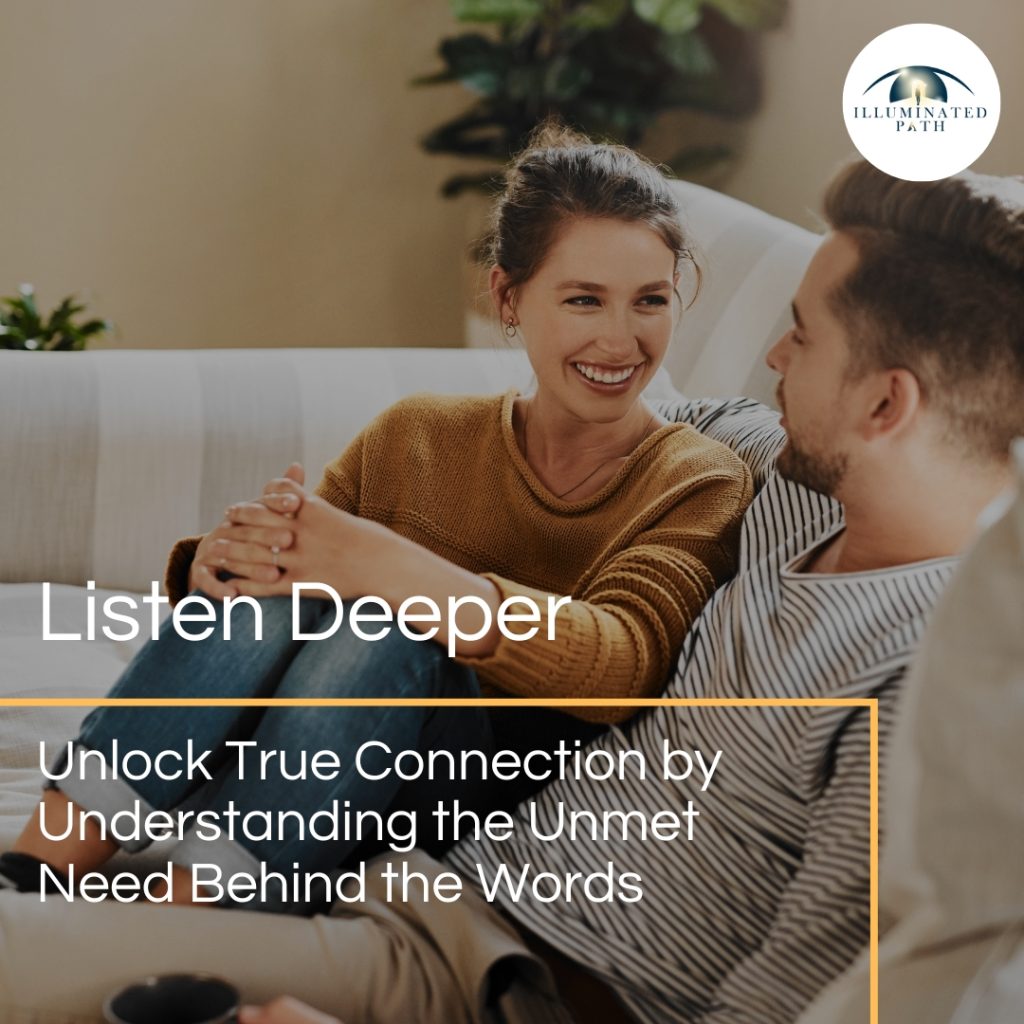
“Listen not to reply, but to understand the unmet need behind the words.” This simple yet profound quote holds the key to transforming the way we connect with others. In everyday conversation, most of us are caught up in formulating responses even before the other person finishes speaking. We hear the words—but often, we miss what’s really being said. The emotional truth. The unspoken need. And that’s where the real magic of connection lives. Listening, at its deepest level, is not about collecting facts. It’s about tuning into the human experience behind the words. And when we do this—when we truly listen with empathy—we unlock deeper trust, melt away resentment, and lay the foundation for authentic, lasting relationships. From Hearing to Listening: The Shift That Changes Everything Let’s begin with a truth that’s easy to overlook: hearing is automatic; listening is intentional. Hearing happens without effort. It’s passive. We hear the hum of traffic or the clatter of dishes in the next room. But listening—that requires presence. Attention. Curiosity. Deep listening is an act of compassion. It’s about silencing the mental chatter and stepping into someone else’s emotional landscape. This kind of listening doesn’t come naturally in our distracted, fast-paced world. But it’s learnable. And it’s worth every ounce of effort. When we shift from simply hearing someone’s words to truly understanding what they’re trying to express—even if they’re not saying it perfectly—we become a safe space for others. That’s when real connection begins. Why People Say What They Say: The Role of Unmet Needs Every word spoken in conflict, every complaint or criticism, every emotional withdrawal, is often a symptom of something deeper: an unmet need. A need for respect. A need to feel seen. A need to belong, to be understood, to matter. When someone says, “You never listen to me,” what they may really mean is: “I feel invisible.” When someone snaps, “You always make it about you,” it might be: “I’m craving space to share what I’m going through.” We often argue at the surface level—about chores, time, tone, who’s right and who’s wrong. But underneath these arguments, if we’re willing to listen deeper, are feelings of fear, loneliness, shame, or pain waiting to be heard. Understanding this changes everything. Instead of reacting defensively, we can respond with empathy. Instead of escalating tension, we can move toward resolution and intimacy. The challenge is learning how to recognize these hidden emotional currents. Empathy Is Not Just a Feeling—It’s an Action Empathy is frequently misunderstood. It’s not just “feeling sorry” for someone. It’s not passive. True empathy is active. It’s the deliberate act of seeing and feeling the world through someone else’s eyes—and then showing them that they’re not alone. Empathetic listening is the primary way we express this action. It starts with presence—being fully here. That means putting down your phone, making eye contact, softening your body language, and turning toward the person as if to say, “I’m here. I’m listening. You matter.” It continues with restraint—resisting the urge to interrupt, fix, judge, or compare. Letting the speaker have their space. Trusting that being heard is often more healing than being advised. And it ends with validation—not necessarily agreement, but acknowledgment. Saying things like, “That sounds really difficult,” or “I can see why you’d feel that way,” is incredibly powerful. It says, “I get you.” That validation is often what people are truly seeking when they open up. How to Practice Deep, Empathetic Listening Like any skill, empathetic listening improves with practice. Here are several techniques to help develop it—not as a checklist, but as a mindset shift. Start with intention. Before you enter a conversation, especially one that might be emotionally charged, remind yourself why you’re listening. Is it to understand, or to win? Is it to connect, or to correct? Your intention will shape your attention. Be fully present. This means giving the speaker your full attention. That’s not just about hearing their words; it’s about tuning in to their tone, their body language, the pauses between their sentences. Often, what’s not said speaks volumes. Pause before responding. We tend to rush in with our own stories or solutions. Instead, let their words settle. A short pause gives both of you space and communicates that you’re taking what they said seriously. Reflect what you hear. This might sound like: “So what I’m hearing is…” or “It sounds like you’re feeling…” This not only shows that you’re engaged—it helps the speaker feel seen and can even clarify things for them. Ask questions—not to probe, but to understand. For example: “What do you need most right now?” or “How long have you been feeling this way?” These kinds of questions invite deeper connection. Validate their emotions. Even if you don’t agree with the logic, you can validate the feeling. “I understand why that would be upsetting,” goes a long way in disarming conflict and building trust. Common Obstacles—and How to Move Through Them Of course, listening deeply isn’t always easy. Sometimes our own emotions or patterns get in the way. Here are a few common roadblocks, and ways to overcome them: 1. You’re triggered.Maybe something they said hit a nerve. You feel yourself tense up, maybe even want to lash out. In this moment, the most compassionate thing you can do—for both of you—is to pause and breathe. If needed, ask for a short break before continuing. Regulation is key to connection. 2. You’re distracted.We all have busy minds and busy lives. But multitasking while someone is sharing something important sends the message that they—and their emotions—are not a priority. Even setting aside five undistracted minutes can completely shift the dynamic. 3. You’re unsure what to say.It’s okay not to have the perfect response. Often, simply saying “Thank you for sharing that with me,” or “I’m here for you,” is enough. Silence, when held with care, is its own form of empathy. Why This Matters in Real Life Empathetic listening isn’t just a nice idea for
Anxiety Is Not a Life Sentence—It’s a Thought Pattern: How to Reshape It with Patience and Practice
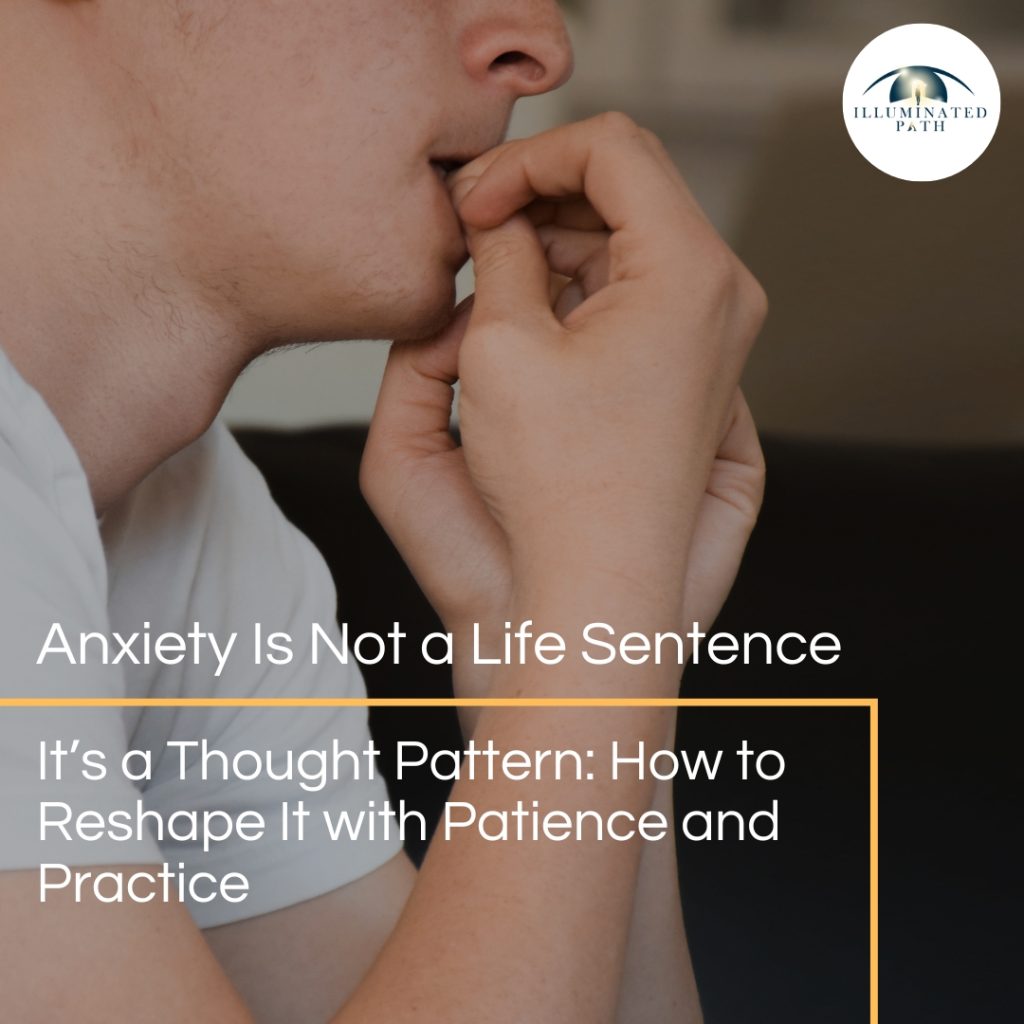
Anxiety can feel like a life sentence—relentless, exhausting, and inescapable. It can settle into your daily life like an unwanted roommate, whispering worst-case scenarios into your ear and clouding even your happiest moments with unease. But here’s the truth: anxiety isn’t your identity, your destiny, or a permanent condition. It’s a pattern of thoughts—learned, habitual, and most importantly, changeable. With awareness, patience, and practice, these thought patterns can be reshaped. If you’re someone who has felt stuck in a cycle of anxious thinking, this post is for you. You’ll learn what anxiety really is, how it operates in the mind, and most importantly, what you can do to break free from its grip—one thought at a time. Understanding Anxiety as a Thought Pattern Let’s begin by redefining anxiety—not as a character flaw, but as a mental habit. Anxiety often stems from repetitive, unhelpful thoughts about what might go wrong. These thoughts are part of a larger system of cognitive distortions—ways the brain tries to make sense of uncertainty but ends up creating distress instead. Some of the most common anxiety-driven thought patterns include: Catastrophizing: Imagining the worst possible outcome in every situation, even if it’s unlikely. All-or-nothing thinking: Believing that things are either perfect or a disaster, with no in-between. Overgeneralizing: Assuming that one bad experience means every similar experience will be bad. Personalization: Blaming yourself for things you’re not actually responsible for. Fortune-telling: Predicting negative outcomes as if they’re facts. These patterns don’t happen because you’re weak or broken. They happen because your brain is trying to protect you—anticipating threats to keep you safe. But when these mental habits run unchecked, they become the source of the very distress they’re trying to prevent. The Brain Can Change—And So Can Your Thoughts One of the most hopeful discoveries in modern psychology and neuroscience is the concept of neuroplasticity. Simply put, your brain can change. When you practice a new thought or behavior repeatedly, your brain creates and strengthens neural pathways to support it. Just like muscles adapt through training, your mind can learn healthier ways of thinking. This is where therapies like Cognitive Behavioral Therapy (CBT) and Mindfulness-Based Cognitive Therapy (MBCT) come in. They don’t just help you cope—they help you retrain your mind. In CBT, you learn to identify distorted thoughts and replace them with more balanced and realistic ones. For example, instead of thinking “I’m going to fail,” you might replace it with “I’ve prepared as best I can, and I’ll do my best.” This small shift changes your emotional response—and over time, it can change your life. Mindfulness, on the other hand, teaches you to observe your thoughts without judgment. When you stop identifying with every anxious thought that enters your mind, you give yourself space to choose how you want to respond, rather than react out of fear. How to Begin Reshaping Anxious Thoughts Changing the way you think doesn’t happen overnight. But it can happen. Here are some practical, proven techniques that support this transformation. 1. Start With Awareness Before you can change a thought, you have to notice it. Pay attention to moments when anxiety spikes. What were you thinking right before you felt anxious? What story were you telling yourself? Keeping a thought journal can be immensely helpful. Write down your anxious thoughts as they come, along with what triggered them and how you responded. Over time, you’ll begin to notice patterns—specific fears, common themes, or situations that set off your anxiety. 2. Challenge the Narrative Once you’ve identified recurring thoughts, it’s time to challenge them. Ask yourself: Is this thought based on facts or fear? What evidence supports this thought? What evidence contradicts it? If my friend had this thought, what would I say to them? This technique, known as cognitive restructuring, helps you replace unhelpful beliefs with more balanced ones. For example, “I’ll never be good enough” might shift into “I’m still learning, and that’s okay.” 3. Practice Mindfulness to Create Space Mindfulness helps you step back from your thoughts instead of getting swept away by them. When practiced regularly, mindfulness increases emotional regulation, reduces reactivity, and strengthens your ability to stay present. Try starting with just five minutes a day. Sit quietly, focus on your breath, and when thoughts arise (as they inevitably will), gently return your attention to your breath. You’re not trying to eliminate thoughts—just observe them without judgment. Over time, this practice builds mental clarity and calm. 4. Run Behavioral Experiments Anxiety thrives on assumptions. One of the most effective ways to test those assumptions is through behavioral experiments. Let’s say you’re convinced that speaking up in meetings will lead to embarrassment. You might challenge this by preparing one small comment to contribute and then noting the outcome. Chances are, the worst-case scenario won’t happen—and you’ll collect evidence that your fear isn’t based in reality. Each time you take a small step toward your fear and find that you’re okay, your brain rewires itself with that new information. Change Takes Time—So Be Patient With Yourself One of the most overlooked parts of anxiety recovery is the importance of patience. Changing thought patterns is like learning a new language—it requires time, repetition, and self-compassion. You’ll have days where your progress feels strong, and days where it feels like you’ve taken three steps back. That’s normal. What matters isn’t perfection, but persistence. Here are a few ways to stay consistent on your journey: Set Realistic Goals Instead of aiming to “get rid of anxiety,” try setting smaller, more achievable intentions, like: “This week, I’ll practice mindfulness for 5 minutes each day.” “I’ll write down one anxious thought and challenge it once a day.” “I’ll speak kindly to myself when I’m feeling overwhelmed.” Consistency is more powerful than intensity when it comes to change. Celebrate Small Wins Anxiety often makes us focus on what’s going wrong. Flip that script by actively acknowledging what’s going right.Did you challenge a negative thought today? Great.Did you pause before reacting to an anxious
Understanding Grief: Why It’s Not a Disorder but the Price We Pay for Love
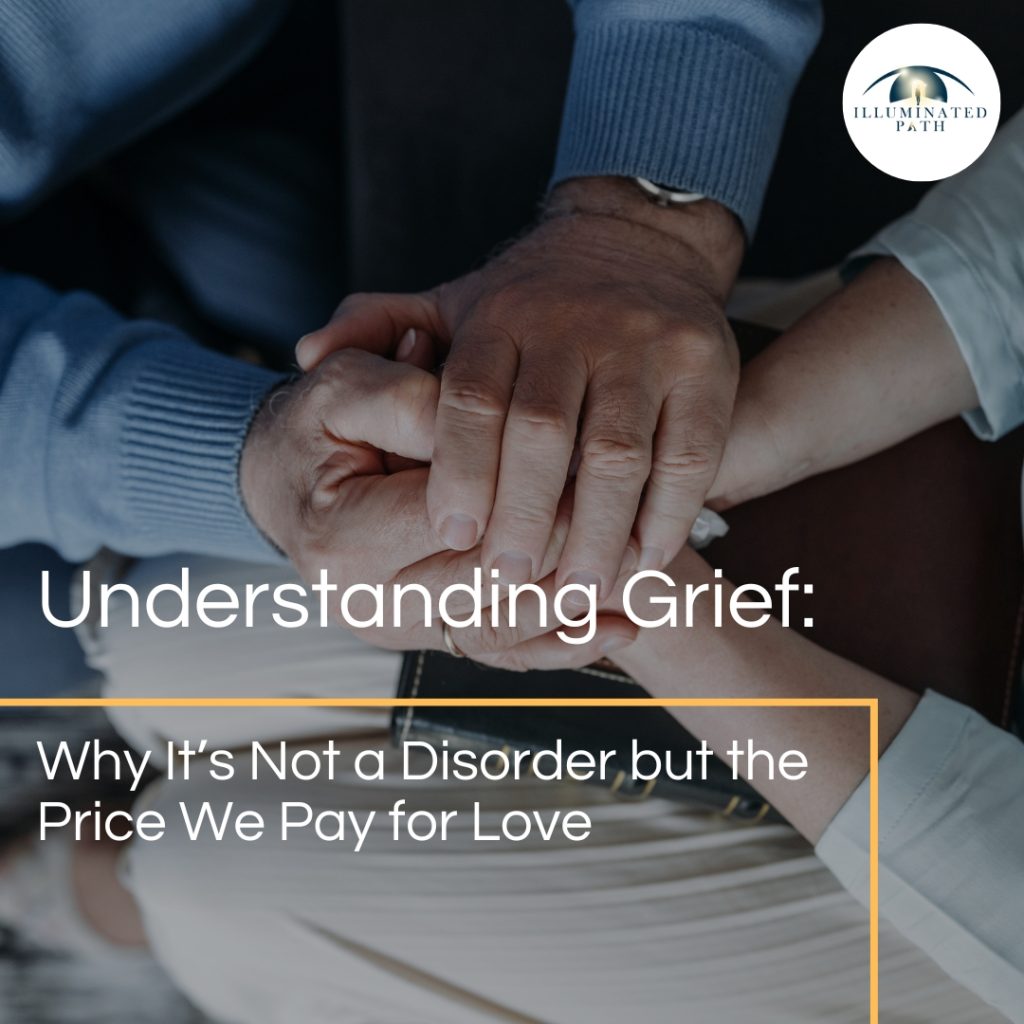
“Grief is not a disorder or a weakness. It is the price of love—a necessity that honors our emotional, physical, and spiritual bonds.” Grief is often misunderstood in our culture. It’s seen as something to hide, rush through, or fix—as if sorrow were a mistake or an illness. But grief is none of these things. Grief is not a malfunction of the human spirit. It is evidence that we dared to love deeply, that we attached, connected, and invested emotionally in someone or something that mattered profoundly. If you’re grieving right now—whether the loss is recent or decades old—this article is for you. Not to diagnose you or to offer a quick fix, but to remind you: your grief is not only valid, it is necessary. Grief Is a Reflection of Love, Not a Sign of Weakness Loss touches every life, and yet when it happens, many people feel completely alone. They wonder if they’re grieving “the right way,” if they’re being too emotional, or if there’s something wrong with them for still hurting months—or years—later. But grief doesn’t follow neat rules or a predetermined timeline. It’s not an error to be corrected or a phase to “get over.” Grief is the soul’s natural response to loss. It is as real and as human as love itself. Rather than a sign of emotional instability, grief is proof that something—or someone—was deeply meaningful. It’s what happens when love has nowhere to go. What Grief Really Is (And Isn’t) Grief extends beyond the death of a loved one. People grieve all kinds of losses: the end of a relationship, the loss of a dream, a major health diagnosis, the passing of a beloved pet, or even the loss of identity that comes with life transitions. There is no one-size-fits-all version of grief. Some feel it as intense sadness, others as numbness or anger. For some, it shows up in the body—fatigue, muscle tension, or changes in sleep and appetite. For others, it emerges more emotionally: a sense of emptiness, guilt, fear, or confusion. There’s also a common misconception that grief unfolds in tidy stages: denial, anger, bargaining, depression, and acceptance. While this model can help people understand that grief has many layers, it’s important to note that people don’t always experience these “stages” in a linear or predictable way. Grief is cyclical, not sequential. You may feel anger long after acceptance, or encounter sadness when you thought you’d moved on. What grief isn’t is pathological. It’s not a personal failure, nor does it mean you’re broken. The feelings you’re experiencing are not only understandable—they’re expected. Why “Moving On” Isn’t the Goal We live in a society that doesn’t know what to do with grief. There’s an unspoken pressure to bounce back quickly, to return to work, to be “strong.” But real grief doesn’t disappear on command, nor should it. When people tell you to “move on,” they often misunderstand what healing really means. You don’t have to move on from someone you loved. You don’t have to stop thinking about them or loving them just because time has passed. In fact, healthy grieving often includes what psychologists call “continuing bonds”—maintaining a sense of connection with the person or part of your life that has been lost, even as you begin to reengage with the present. Grief doesn’t end. It evolves. With time and care, what was once unbearable becomes something you carry with more ease. It becomes part of your story, but not the whole of it. Grief as a Sacred Process: The Physical, Emotional, and Spiritual Impact When grief hits, it affects every layer of our being: Emotionally, it can bring waves of sorrow, regret, gratitude, anger, or even moments of joy when recalling a meaningful memory. Physically, grief is exhausting. You may feel drained, experience aches and pains, or struggle with appetite and sleep. This is your body reacting to the intense stress of emotional pain. Spiritually, grief often prompts deep questioning. You may wrestle with meaning, identity, faith, or the purpose of suffering and connection. Far from being symptoms of a disorder, these reactions reflect the totality of our loss. Grief reminds us of the depth of our bonds—and how profoundly human it is to feel them. When Grief Feels Like Too Much While grief is a natural process, sometimes it can become so heavy that it feels unbearable. If you’re stuck in sadness that doesn’t shift, struggling with guilt or anger you can’t understand, or feeling like you’re losing your sense of self, these are signs that you may benefit from additional support. There’s also a form of grief known as complicated grief or prolonged grief disorder. This occurs when the natural healing process becomes stalled, and symptoms persist or intensify over time. People with complicated grief often feel unable to move forward, avoid reminders of the loss, or feel detached from life. But here’s the truth: there is no shame in needing help. Therapy isn’t just for crisis—it’s also for care. If your grief is starting to interfere with daily functioning or quality of life, a trained therapist can help you process your emotions, reduce isolation, and move toward healing at your own pace. How Grief Therapy Helps Grief therapy offers a compassionate space where your loss can be witnessed, not minimized. It allows you to: Tell your story without fear of judgment or pressure to “be okay.” Understand the complex emotions you’re experiencing. Explore unresolved feelings, such as guilt, anger, or regret. Develop coping tools that support your mental and emotional well-being. Honor your loss while slowly rebuilding your relationship with life. There is no “right” time to begin therapy. You may feel ready weeks after a loss, or not until years later. What matters most is that you’re supported in a way that feels safe and sustainable. Therapists who specialize in grief often use a variety of modalities—including talk therapy, mindfulness-based strategies, EMDR (Eye Movement Desensitization and Reprocessing), narrative therapy, and somatic practices—to meet
From Survival to Empowerment: Healing Childhood Trauma and Embracing Your Inner Strength.
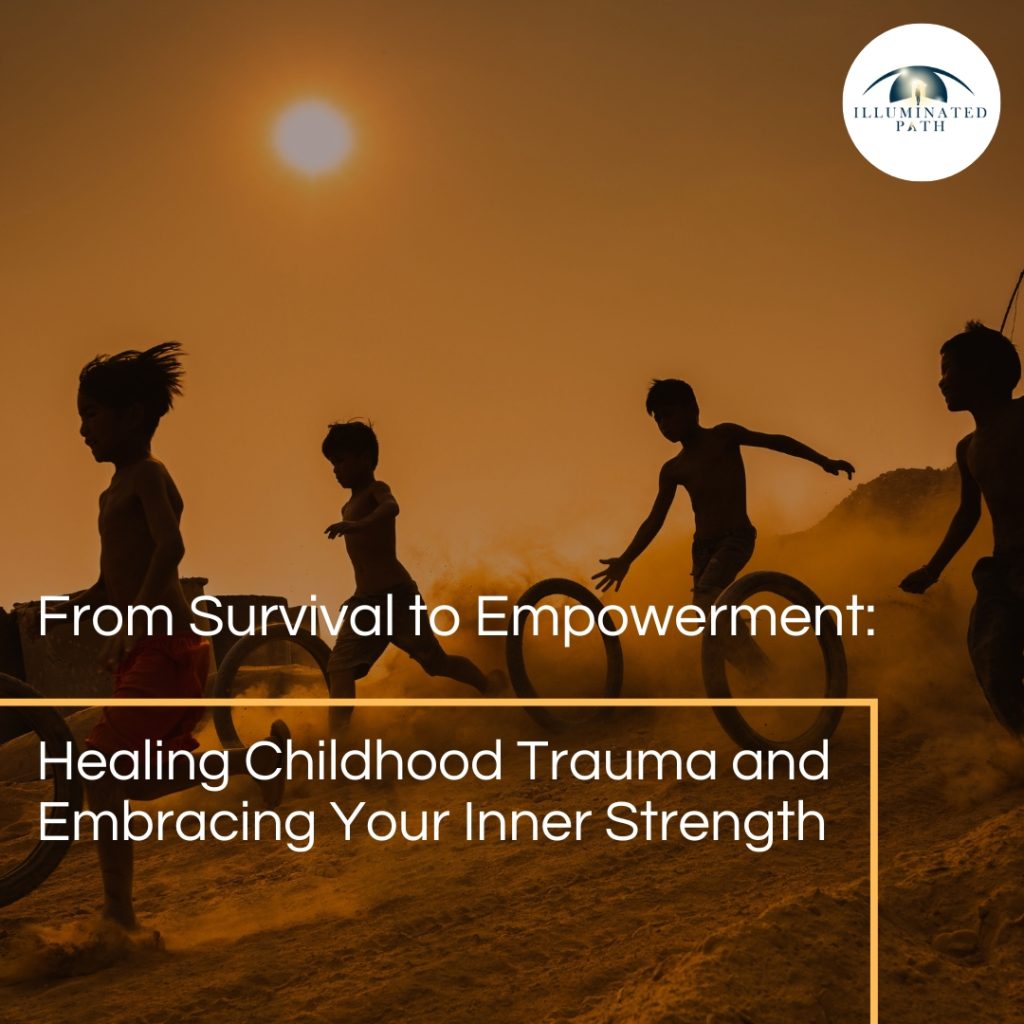
True intimacy begins where performance ends. It’s not about perfection or constant agreement. It’s about two people showing up authentically—vulnerabilities, fears, and all—without the fear of judgment. This kind of connection is rare, but it’s also the most rewarding. What Is True Intimacy? (And What It’s Not) Intimacy is often confused with physical closeness or romantic gestures. But true intimacy is emotional and psychological. It’s the deep sense of closeness that comes from mutual openness, trust, and emotional safety. True intimacy is: Being able to share your deepest thoughts and feelings without fear Feeling emotionally safe and accepted Being seen and loved for your authentic self True intimacy is not: Constant agreement or avoiding conflict Performing or pretending to be someone you’re not Relying solely on physical closeness without emotional connection As noted by Psychology Today, emotional intimacy is the glue that holds relationships together, enabling individuals to express their true selves without fear of judgment or rejection . Why Vulnerability Is the Gateway to Connection Dr. Brené Brown, a leading researcher on vulnerability, says: “Vulnerability is the birthplace of love, belonging, joy, courage, empathy, and creativity.” the outcome. It’s the willingness to say, “This is me,” even when we fear rejection. When both partners embrace vulnerability, they create a space where true intimacy can flourish. It allows for deeper understanding, empathy, and connection . The Fear of Judgment: Intimacy’s Greatest Barrier Many people avoid vulnerability because they fear judgment or rejection. This fear can prevent partners from sharing their true feelings and experiences, leading to a lack of emotional connection . Common fears include: “If I show my true self, they won’t love me.” “If I express my needs, I’ll seem needy or weak.” “If I reveal my past, they’ll judge me.” These fears can lead to emotional walls, preventing genuine connection. But hiding your true thoughts and needs erodes trust because genuine intimacy requires openness . How to Cultivate True Intimacy in Your Relationship Building true intimacy requires intentional effort and mutual commitment. Here are practical steps to deepen your connection: 1. Practice Radical Honesty Share your thoughts and feelings openly, even when it’s uncomfortable. Honesty fosters trust and allows your partner to understand your inner world. 2. Create a Judgment-Free Zone Encourage open dialogue without criticism or defensiveness. Listen actively and validate your partner’s experiences. 3. Share What Scares You Discuss your fears and insecurities. This vulnerability can lead to deeper empathy and connection. 4. Make Space for Each Other’s Inner World Be curious about your partner’s thoughts and feelings. Ask open-ended questions and show genuine interest. 5. Build Trust Through Consistency and Care Follow through on promises and be reliable. Consistent actions build a foundation of trust. By prioritizing emotional intimacy, you create a solid foundation for a fulfilling and lasting partnership . The Payoff: Why True Intimacy Is Worth the Risk Embracing vulnerability and cultivating true intimacy can lead to: Greater Relationship Satisfaction: Couples who share openly experience deeper connection and fulfillment. Enhanced Emotional Resilience: Facing challenges together strengthens the bond and builds resilience. Increased Trust and Security: Consistent honesty and openness foster a safe and trusting environment. Emotional intimacy is the glue that holds relationships together, enabling individuals to express their true selves without fear of judgment or rejection . Final Thoughts: Choose Vulnerability Over Performance True intimacy requires courage—the courage to be seen, to be vulnerable, and to risk rejection. But the reward is profound: a deep, authentic connection where both partners feel valued, understood, and loved. Reflect on your relationships: Are you showing up authentically? Are you creating a safe space for your partner to do the same? Embrace vulnerability. Let go of the fear of judgment. And experience the transformative power of true intimacy. The Author Dr. Shadi Souferian Psy. D. Licensed Clinical Psychologist Therapist And Psychologist in Los Angeles And Beverly Hills. You might also enjoy this article: Understanding Grief: Why It’s Not a Disorder but the Price We Pay for Love April 28, 2025Life Transformation “Grief is not a disorder or a weakness. It is the price of love—a necessity…Read more From Survival to Empowerment: Healing Childhood Trauma and Embracing Your Inner Strength. April 22, 2025Life TransformationPersonal Development True intimacy begins where performance ends. It’s not about perfection or constant agreement. It’s about…Read more True Intimacy: The Power of Being Fully Seen Without Fear of Judgment. April 19, 2025Relationship True intimacy begins where performance ends. It’s not about perfection or constant agreement. It’s about…Read more How Resilience Helps Us Overcome Stress: Adapt, Don’t Avoid April 15, 2025Personal Development Introduction: Why Resilience Matters Now More Than Ever Whether it’s the pressure of deadlines, a…Read more Beyond Words: Why True Empathic Listening is the Cornerstone of a Powerful Relationship March 26, 2025Relationship In the intricate dance of human connection, particularly within the intimate sphere of a romantic…Read more When the Smoke Detector Never Stops Beeping: Understanding and Addressing Chronic Anxiety March 18, 2025Personal DevelopmentTrauma Daniel Goleman, the renowned expert on emotional intelligence, offered a potent analogy for understanding anxiety:…Read more
True Intimacy: The Power of Being Fully Seen Without Fear of Judgment.
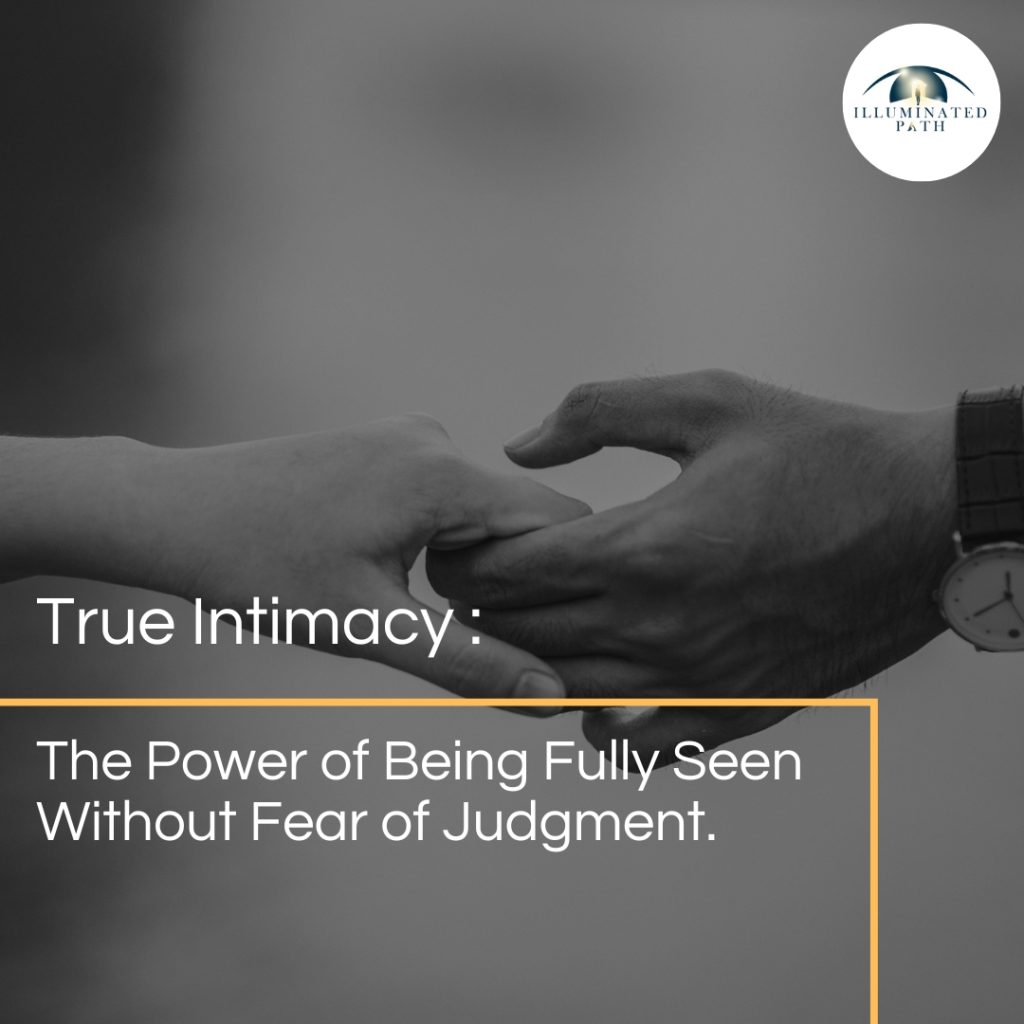
True intimacy begins where performance ends. It’s not about perfection or constant agreement. It’s about two people showing up authentically—vulnerabilities, fears, and all—without the fear of judgment. This kind of connection is rare, but it’s also the most rewarding. What Is True Intimacy? (And What It’s Not) Intimacy is often confused with physical closeness or romantic gestures. But true intimacy is emotional and psychological. It’s the deep sense of closeness that comes from mutual openness, trust, and emotional safety. True intimacy is: Being able to share your deepest thoughts and feelings without fear Feeling emotionally safe and accepted Being seen and loved for your authentic self True intimacy is not: Constant agreement or avoiding conflict Performing or pretending to be someone you’re not Relying solely on physical closeness without emotional connection As noted by Psychology Today, emotional intimacy is the glue that holds relationships together, enabling individuals to express their true selves without fear of judgment or rejection . Why Vulnerability Is the Gateway to Connection Dr. Brené Brown, a leading researcher on vulnerability, says: “Vulnerability is the birthplace of love, belonging, joy, courage, empathy, and creativity.” the outcome. It’s the willingness to say, “This is me,” even when we fear rejection. When both partners embrace vulnerability, they create a space where true intimacy can flourish. It allows for deeper understanding, empathy, and connection . The Fear of Judgment: Intimacy’s Greatest Barrier Many people avoid vulnerability because they fear judgment or rejection. This fear can prevent partners from sharing their true feelings and experiences, leading to a lack of emotional connection . Common fears include: “If I show my true self, they won’t love me.” “If I express my needs, I’ll seem needy or weak.” “If I reveal my past, they’ll judge me.” These fears can lead to emotional walls, preventing genuine connection. But hiding your true thoughts and needs erodes trust because genuine intimacy requires openness . How to Cultivate True Intimacy in Your Relationship Building true intimacy requires intentional effort and mutual commitment. Here are practical steps to deepen your connection: 1. Practice Radical Honesty Share your thoughts and feelings openly, even when it’s uncomfortable. Honesty fosters trust and allows your partner to understand your inner world. 2. Create a Judgment-Free Zone Encourage open dialogue without criticism or defensiveness. Listen actively and validate your partner’s experiences. 3. Share What Scares You Discuss your fears and insecurities. This vulnerability can lead to deeper empathy and connection. 4. Make Space for Each Other’s Inner World Be curious about your partner’s thoughts and feelings. Ask open-ended questions and show genuine interest. 5. Build Trust Through Consistency and Care Follow through on promises and be reliable. Consistent actions build a foundation of trust. By prioritizing emotional intimacy, you create a solid foundation for a fulfilling and lasting partnership . The Payoff: Why True Intimacy Is Worth the Risk Embracing vulnerability and cultivating true intimacy can lead to: Greater Relationship Satisfaction: Couples who share openly experience deeper connection and fulfillment. Enhanced Emotional Resilience: Facing challenges together strengthens the bond and builds resilience. Increased Trust and Security: Consistent honesty and openness foster a safe and trusting environment. Emotional intimacy is the glue that holds relationships together, enabling individuals to express their true selves without fear of judgment or rejection . Final Thoughts: Choose Vulnerability Over Performance True intimacy requires courage—the courage to be seen, to be vulnerable, and to risk rejection. But the reward is profound: a deep, authentic connection where both partners feel valued, understood, and loved. Reflect on your relationships: Are you showing up authentically? Are you creating a safe space for your partner to do the same? Embrace vulnerability. Let go of the fear of judgment. And experience the transformative power of true intimacy. The Author Dr. Shadi Souferian Psy. D. Licensed Clinical Psychologist Therapist And Psychologist in Los Angeles And Beverly Hills. You might also enjoy this article: True Intimacy: The Power of Being Fully Seen Without Fear of Judgment. April 19, 2025Relationship True intimacy begins where performance ends. It’s not about perfection or constant agreement. It’s about…Read more How Resilience Helps Us Overcome Stress: Adapt, Don’t Avoid April 15, 2025Personal Development Introduction: Why Resilience Matters Now More Than Ever Whether it’s the pressure of deadlines, a…Read more Beyond Words: Why True Empathic Listening is the Cornerstone of a Powerful Relationship March 26, 2025Relationship In the intricate dance of human connection, particularly within the intimate sphere of a romantic…Read more When the Smoke Detector Never Stops Beeping: Understanding and Addressing Chronic Anxiety March 18, 2025Personal DevelopmentTrauma Daniel Goleman, the renowned expert on emotional intelligence, offered a potent analogy for understanding anxiety:…Read more The Silent Crisis: Parental Burnout and Hidden Stress in Modern Families March 11, 2025Parenting Modern parenting is often depicted as a journey filled with immense joy and profound love,…Read more Designing a Healing Space: How Environment Impacts Mental Health March 4, 2025Therapy Room The spaces we inhabit are not passive backdrops to our lives—they actively shape our emotions,…Read more
How Resilience Helps Us Overcome Stress: Adapt, Don’t Avoid
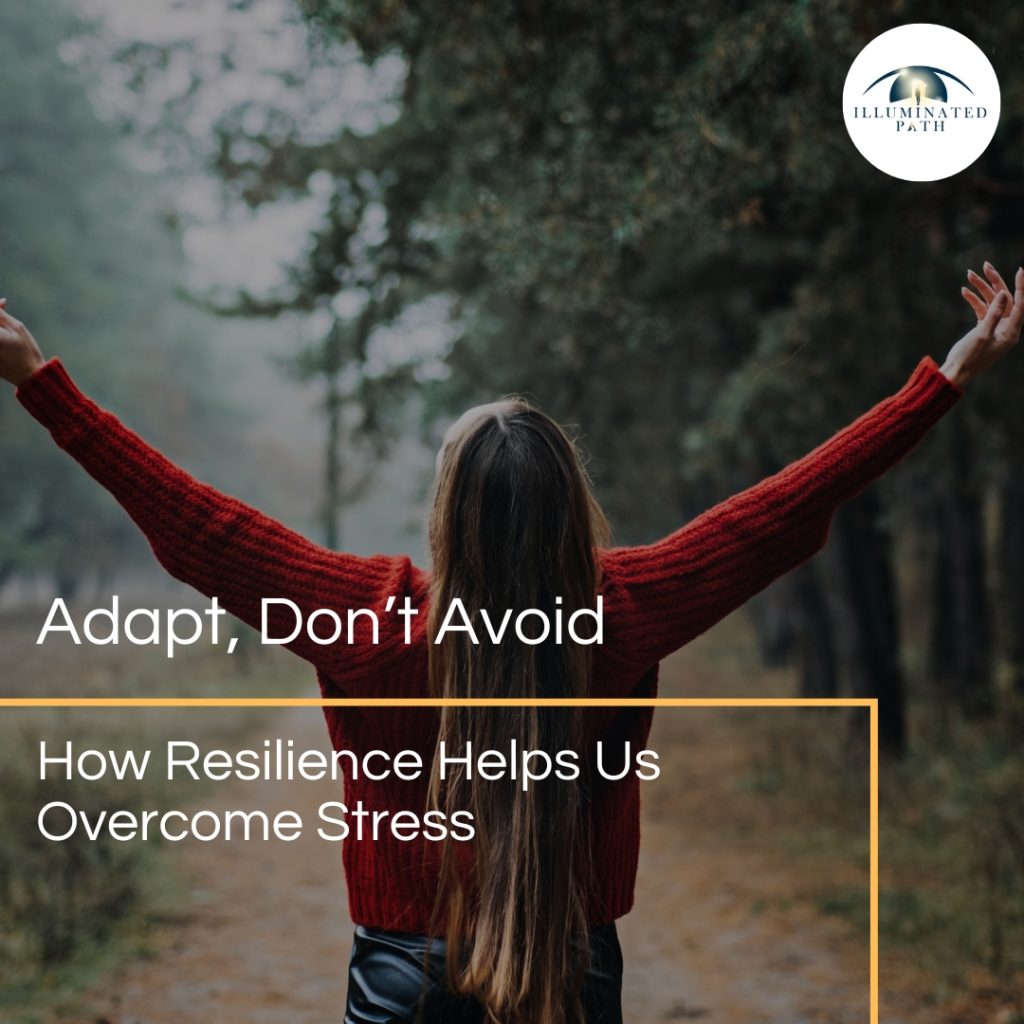
Introduction: Why Resilience Matters Now More Than Ever Whether it’s the pressure of deadlines, a strained relationship, or the weight of global uncertainty, stress touches every corner of modern life. But while we can’t always control our circumstances, we can change how we respond to them. That’s where resilience comes in. More than just “toughing it out,” true resilience is about learning to adapt — not avoid — in the face of adversity. In this post, we’ll explore how resilience helps us overcome stress, why avoidance backfires, and how you can start building the adaptive habits that strengthen you from the inside out. What Is Resilience? (And What It Isn’t) Resilience is often misunderstood. It’s not about having a stiff upper lip or bouncing back instantly from hardship. Psychologists define resilience as the capacity to recover from difficulties through adaptation and growth. What resilience is not: Suppressing your feelings Pretending everything is fine Avoiding hard conversations or decisions Instead, resilience involves acknowledging discomfort and then choosing to engage with it in a way that promotes healing and forward movement. Resilience is built through adaptation — not avoidance. The Science Behind Resilience and Stress When we experience stress, our bodies activate the fight-or-flight response: our heart rate increases, cortisol floods our system, and we prepare to either confront or escape the threat. But when stress is chronic, or when we avoid addressing its sources, this system goes into overdrive — draining our energy and affecting both physical and mental health. Here’s the good news: resilience is not fixed. Thanks to neuroplasticity, our brains can learn to respond more effectively over time. Studies show that people who cultivate adaptive responses — like reframing thoughts or seeking support — experience: Lower levels of anxiety and depression Greater problem-solving ability Better overall health outcomes Avoidance vs. Adaptation: Why Avoiding Stress Makes It Worse Avoidance might feel good in the short term, but it often leads to more suffering in the long run. Common Avoidance Strategies: Procrastinating important tasks Withdrawing from others Distracting yourself with food, screens, or substances Pretending “everything is fine” These behaviors might provide temporary relief, but they delay growth and allow problems to fester. Adaptive Responses (What Resilience Looks Like): Facing stressors head-on with curiosity and calm Accepting what’s outside of your control Taking meaningful action, even when it’s uncomfortable Resilience means recognizing that challenges won’t vanish if you ignore them. Instead, growth comes from learning how to face them. How to Build Resilience Through Adaptation: 5 Proven Strategies 1. Embrace Discomfort as a Growth Zone Stepping into discomfort — in small, manageable ways — helps your nervous system learn that difficulty isn’t danger. Try a new habit, tackle a hard task, or have that honest conversation you’ve been avoiding. 2. Practice Cognitive Flexibility Resilient people know how to reframe their thoughts. Instead of thinking “I can’t handle this,” ask “What can I learn from this?” Flexibility in thinking helps reduce rumination and opens space for solutions. 3. Strengthen Social Connections Human beings are wired for connection. Talking to a friend, mentor, or support group about your challenges can build resilience faster than facing stress alone. 4. Cultivate Emotional Awareness Mindfulness, journaling, and therapy help us name our emotions — a key part of emotional regulation. The more self-aware you are, the easier it becomes to adapt rather than react. 5. Commit to Purposeful Action Purpose gives us direction. Whether it’s work, family, or a cause, having a sense of meaning helps us persist through hardship. Resilience grows when you act in line with your values, even when it’s tough. When to Seek Help: Resilience Includes Knowing Your Limits Resilience doesn’t mean “go it alone.” Knowing when to reach out — to a therapist, counselor, or support group — is a powerful act of adaptation. If you’re feeling overwhelmed, anxious, or stuck in cycles of avoidance, professional help can guide you toward healthier responses. Conclusion: Choose Adaptation Over Avoidance Stress is inevitable — but suffering doesn’t have to be. The difference lies in how we respond. By choosing adaptation over avoidance, we build resilience that lasts. Not by pretending stress isn’t there, but by leaning into it with the tools, support, and mindset that help us grow stronger. You don’t have to bounce back — you just have to move forward. The Author Dr. Shadi Souferian Psy. D. Licensed Clinical Psychologist Therapist And Psychologist in Los Angeles And Beverly Hills. You might also enjoy this article: How Resilience Helps Us Overcome Stress: Adapt, Don’t Avoid April 15, 2025Personal Development Introduction: Why Resilience Matters Now More Than Ever Whether it’s the pressure of deadlines, a…Read more Beyond Words: Why True Empathic Listening is the Cornerstone of a Powerful Relationship March 26, 2025Relationship In the intricate dance of human connection, particularly within the intimate sphere of a romantic…Read more When the Smoke Detector Never Stops Beeping: Understanding and Addressing Chronic Anxiety March 18, 2025Personal DevelopmentTrauma Daniel Goleman, the renowned expert on emotional intelligence, offered a potent analogy for understanding anxiety:…Read more The Silent Crisis: Parental Burnout and Hidden Stress in Modern Families March 11, 2025Parenting Modern parenting is often depicted as a journey filled with immense joy and profound love,…Read more Designing a Healing Space: How Environment Impacts Mental Health March 4, 2025Therapy Room The spaces we inhabit are not passive backdrops to our lives—they actively shape our emotions,…Read more Beyond the Flames: Understanding the Long-Term Impact of Wildfire Trauma on LA Communities February 26, 2025Trauma The iconic image of Los Angeles is often one of sunshine, beaches, and Hollywood glamour.…Read more
Beyond Words: Why True Empathic Listening is the Cornerstone of a Powerful Relationship
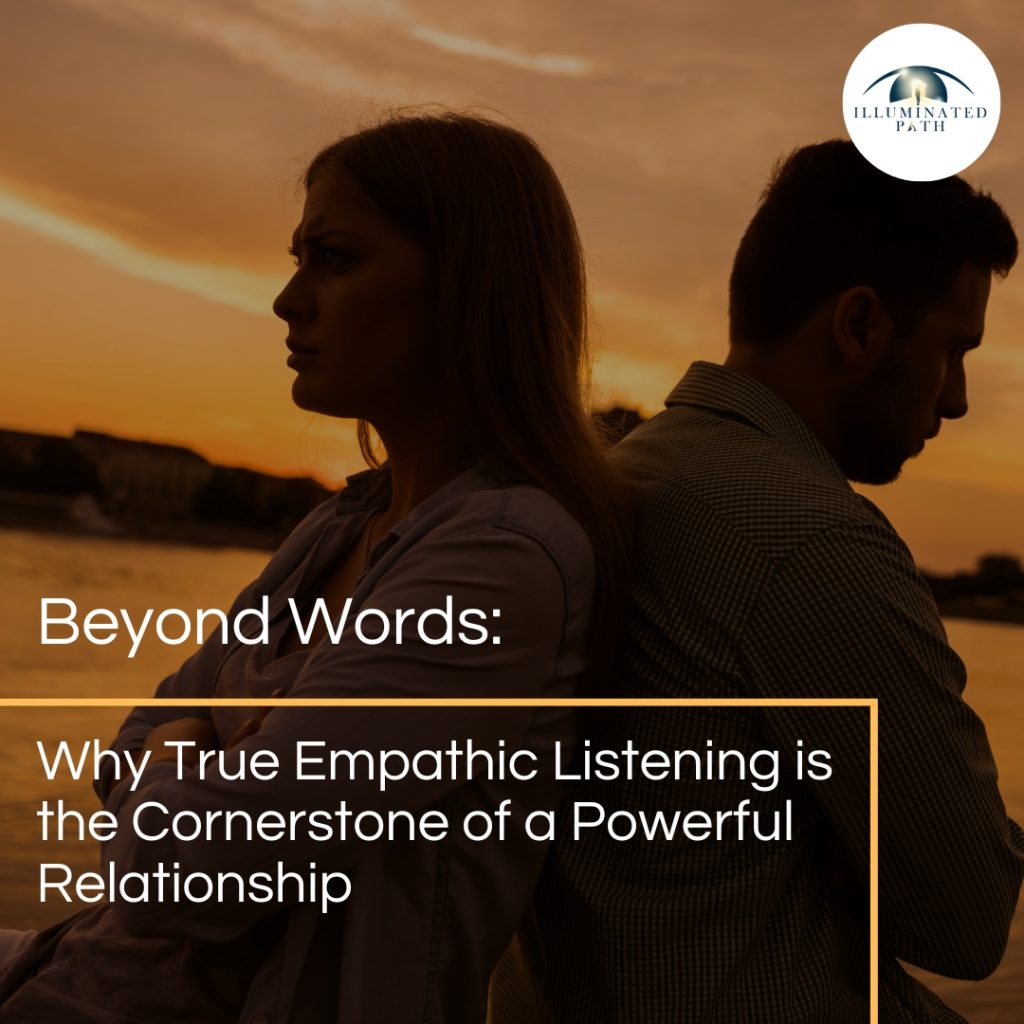
In the intricate dance of human connection, particularly within the intimate sphere of a romantic partnership, we often place immense value on the power of communication. We strive to articulate our needs, share our joys, and express our vulnerabilities through carefully chosen words. We engage in debates, navigate disagreements, and attempt to bridge the gaps in understanding through the verbal exchange of thoughts and feelings. And yet, amidst this focus on speaking, a far more profound and often overlooked skill lies waiting to unlock the true potential of our relationships: true empathic listening. It’s a concept often paid lip service to, a bullet point in relationship advice articles, but rarely explored in its full depth and transformative power. We might believe we are good listeners, nodding along, offering occasional interjections, and waiting for our turn to speak. However, genuine empathic listening transcends mere hearing; it delves into the emotional landscape of our partner, seeking to understand not just the words being spoken, but the unspoken feelings, the underlying needs, and the unique perspective that shapes their experience. It is not simply about absorbing information; it is about actively engaging with another human being on a profound emotional level, creating a safe and validating space where true connection can flourish. We will explore what it truly means to listen with empathy, differentiate it from other forms of listening, and unpack the myriad benefits it brings to a partnership, ultimately demonstrating why it is often the silence, filled with understanding, that speaks volumes in the language of love. The Illusion of Listening: Decoding Different Listening Styles Before we can truly appreciate the power of empathic listening, it’s crucial to recognize the various ways we often engage in what we perceive as listening, and how these fall short of genuine empathy. Passive Listening: This is perhaps the most basic form, where we are physically present but our minds may be elsewhere. We might hear the words, but we are not actively processing them, nor are we attuned to the emotional undertones. It’s akin to background noise, failing to create any real connection. Selective Listening: In this mode, we tune in only to the parts of the conversation that interest us or align with our own agenda. We might filter out information that challenges our beliefs or requires us to step outside our comfort zone, missing crucial aspects of our partner’s experience. Competitive Listening: This style is characterized by a focus on waiting for our turn to speak, often formulating our response while our partner is still talking. The primary goal is to share our own thoughts or opinions, rather than truly understanding the other person’s perspective. Conversations become a battle for airtime, hindering genuine connection. Attentive Listening: This is a step closer to empathic listening, involving paying attention to the words being spoken, making eye contact, and offering verbal cues like “uh-huh” or “I see.” While demonstrating engagement, it may still lack the deeper emotional connection that defines empathy. True Empathic Listening: Stepping into Your Partner’s Shoes True empathic listening goes beyond these superficial forms of engagement. It is a conscious and intentional act of fully immersing ourselves in our partner’s experience, striving to understand their world as they perceive it. It involves several key components: Active Focus: Empathic listening demands our complete attention, both mentally and physically. This means minimizing distractions, putting aside our own thoughts and judgments, and being fully present in the moment with our partner. It requires a conscious effort to quiet our internal monologue and direct our energy towards understanding them. Emotional Attunement: It’s not enough to simply hear the words; we must also be attuned to the emotions underlying them. This involves observing their body language, tone of voice, and facial expressions to gain a deeper understanding of how they are feeling. It requires us to tap into our own capacity for empathy and imagine what it might be like to be in their situation. Perspective Taking: Empathic listening necessitates a genuine attempt to see the situation from our partner’s point of view, even if we don’t necessarily agree with it. This involves suspending our own biases and assumptions and trying to understand their motivations, fears, and desires. It’s about acknowledging the validity of their experience, even if it differs from our own. Validation: A crucial aspect of empathic listening is validating our partner’s feelings. This doesn’t mean we have to agree with their perspective or condone their actions, but it does mean acknowledging that their emotions are real and important. Phrases like “That sounds really frustrating” or “I can see why you would feel that way” can create a sense of being heard and understood, fostering emotional safety. Reflecting and Clarifying: To ensure we are truly understanding our partner, empathic listening involves reflecting back what we have heard, both in terms of content and emotion. This might involve paraphrasing their words or summarizing their feelings to confirm our understanding. Asking clarifying questions demonstrates our genuine interest and allows our partner to elaborate further. Non-Judgmental Presence: Empathic listening requires us to approach our partner without judgment or criticism. When we feel judged, we are less likely to open up and share our true selves. Creating a non-judgmental space allows for vulnerability and fosters a deeper sense of trust and intimacy. The Transformative Power of Empathic Listening in Relationships When true empathic listening becomes a consistent practice within a relationship, its impact is profound and far-reaching: Deepened Emotional Connection: By truly hearing and understanding our partner’s inner world, we forge a deeper emotional bond. It creates a sense of being seen, understood, and valued, which are fundamental needs in any intimate relationship. This emotional connection acts as a strong foundation, weathering the inevitable storms of life. Enhanced Trust and Security: When we consistently feel heard and validated by our partner, it builds a strong sense of trust and security within the relationship. Knowing that our feelings and experiences
When the Smoke Detector Never Stops Beeping: Understanding and Addressing Chronic Anxiety
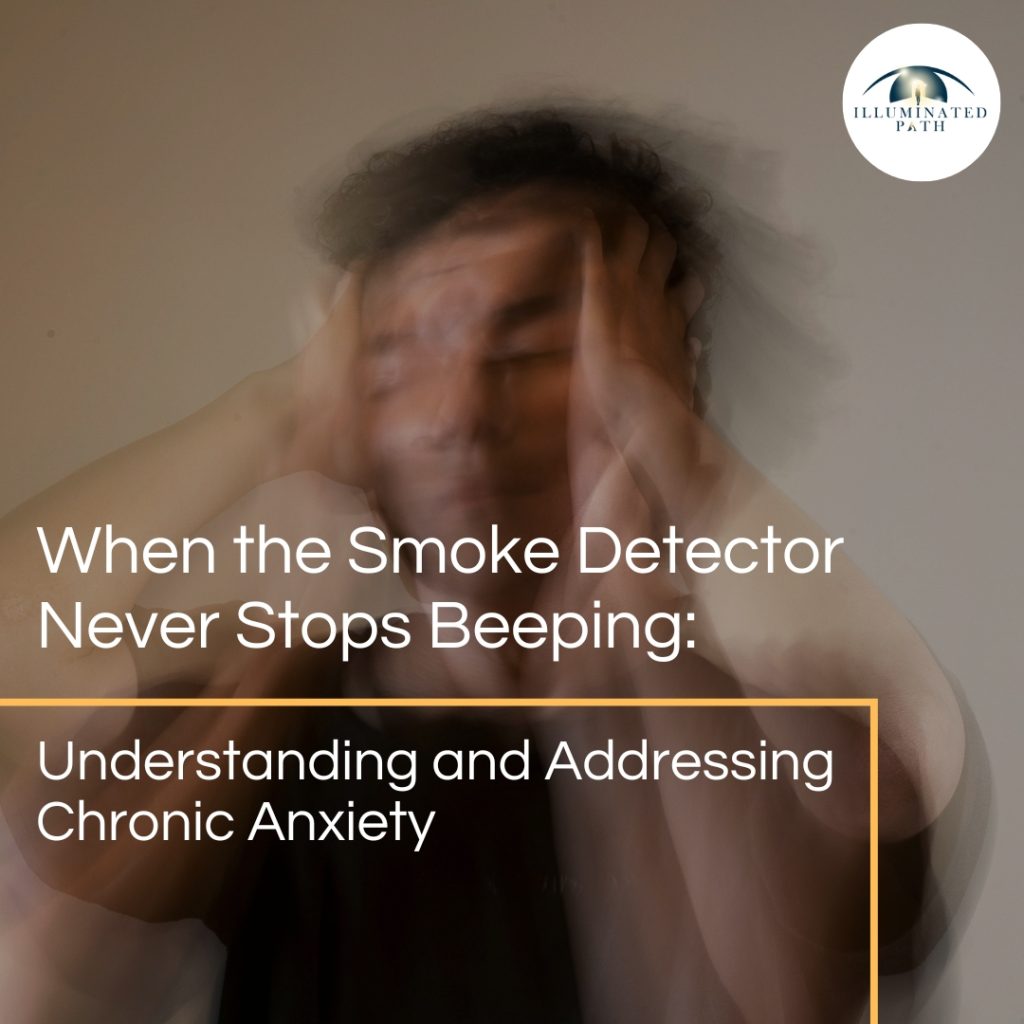
Daniel Goleman, the renowned expert on emotional intelligence, offered a potent analogy for understanding anxiety: “Anxiety is the mind’s smoke detector – sometimes it warns of real danger, often it’s just burnt toast. Learn to tell the difference.” This simple yet profound statement encapsulates a crucial aspect of navigating our inner world. However, what happens when the smoke detector malfunctions, relentlessly blaring even in the absence of smoke, or worse, when the “burnt toast” triggers a full-blown, ear-splitting alarm? This is the realm of chronic anxiety, a persistent and often debilitating condition that extends far beyond occasional worries or fleeting moments of unease. For those living with chronic anxiety, Goleman’s wisdom, while insightful, can feel like a distant shore. The constant barrage of anxious thoughts, physical sensations, and anticipatory dread makes it incredibly difficult to discern between genuine threats and the mind’s overactive imagination. The smoke detector, meant to be a helpful guardian, becomes a tyrannical overlord, dictating every thought and action, casting a long shadow over daily life. This article delves into the multifaceted nature of chronic anxiety, exploring its profound impact, the critical juncture where professional help becomes essential, potential underlying causes, effective treatment options, and ultimately, how to begin the journey of quieting the incessant alarm and learning to distinguish genuine danger from internal noise. The Unrelenting Symphony of Chronic Anxiety: A Life Lived on High Alert Chronic anxiety isn’t merely feeling a bit worried before a presentation or experiencing pre-exam jitters. It’s a pervasive state of apprehension and unease that lingers for extended periods, often months or even years. It’s a constant hum of worry in the background, occasionally escalating into full-blown panic attacks, but always present in some form. This persistent state of hyperarousal can manifest in a myriad of ways, impacting virtually every facet of an individual’s life: Cognitive Landscape: The mind becomes a breeding ground for intrusive thoughts, often negative, catastrophic, or repetitive. Worry becomes a default mode, with individuals constantly scanning for potential threats, real or imagined. Decision-making becomes fraught with difficulty, as every option is weighed against potential negative outcomes. Concentration and focus dwindle, making even simple tasks feel monumental. Memory can also be affected by the constant mental chatter. Emotional Turmoil: Beyond worry, chronic anxiety can fuel a range of negative emotions, including fear, irritability, restlessness, and a sense of being overwhelmed. Individuals may experience a persistent feeling of being “on edge,” unable to relax or find peace of mind. This emotional exhaustion can lead to feelings of sadness, hopelessness, and even contribute to the development of depression. Physical Manifestations: The mind-body connection is undeniable, and chronic anxiety takes a significant toll on physical health. Common symptoms include muscle tension, headaches, stomachaches, digestive issues (like irritable bowel syndrome), fatigue, sleep disturbances (insomnia, restless sleep), rapid heartbeat, sweating, and shortness of breath. These physical symptoms can be distressing in themselves, often exacerbating the underlying anxiety and creating a vicious cycle. Behavioral Adaptations: To cope with the relentless anxiety, individuals may develop avoidance behaviors. They might start avoiding social situations, work responsibilities, or even everyday activities that trigger their anxiety. This avoidance, while providing temporary relief, ultimately limits their lives, shrinks their world, and reinforces the anxiety. Other maladaptive coping mechanisms, such as excessive reassurance seeking, procrastination, or engaging in rituals, may also emerge. Impact on Relationships: Chronic anxiety can strain interpersonal relationships. Irritability, difficulty relaxing and enjoying time together, and avoidance behaviors can lead to misunderstandings and conflict. Loved ones may struggle to understand the intensity of the anxiety and may feel helpless or frustrated. The cumulative effect of these symptoms can be profoundly debilitating. Individuals with chronic anxiety may find it difficult to perform at work or school, maintain healthy relationships, pursue their hobbies, or simply enjoy life. The constant internal struggle can lead to feelings of isolation, shame, and a diminished sense of self-worth. When the Alarm Bells Demand Attention: Recognizing the Need for Professional Help While everyone experiences anxiety to some degree, chronic anxiety is qualitatively and quantitatively different. It’s not something that can be simply “willed away” or overcome with positive thinking alone. Recognizing when the “smoke detector” is malfunctioning to the point of requiring professional intervention is a crucial step towards recovery. Here are some key indicators that suggest it’s time to seek help: Persistence and Intensity: The anxiety is persistent, lasting for several months or longer, and its intensity significantly interferes with daily functioning. Impairment of Daily Life: Anxiety makes it difficult to perform everyday tasks at work, school, or home. It impacts concentration, productivity, and overall performance. Relationship Strain: Anxiety is negatively affecting relationships with family, friends, or romantic partners, leading to conflict, avoidance, or isolation. Physical Symptoms: Physical symptoms associated with anxiety are frequent, severe, and causing significant discomfort or concern. Avoidance Behaviors: You find yourself increasingly avoiding situations or activities that trigger anxiety, leading to a restricted lifestyle. Difficulty Controlling Worry: You feel overwhelmed by your worries and find it difficult to control or stop the flow of anxious thoughts. Panic Attacks: You experience recurrent panic attacks – sudden episodes of intense fear accompanied by physical symptoms like rapid heartbeat, dizziness, and shortness of breath. Co-occurring Conditions: You suspect or have been diagnosed with other mental health conditions, such as depression or substance use disorders, which often co-occur with anxiety. Decreased Quality of Life: Overall, your anxiety is significantly impacting your enjoyment of life, your sense of well-being, and your ability to pursue your goals. Acknowledging the need for help is not a sign of weakness but rather an act of self-awareness and strength. Chronic anxiety is a treatable condition, and seeking professional support is the first step towards regaining control and silencing the incessant alarm. Unraveling the Roots: Exploring Potential Underlying Causes of Chronic Anxiety The development of chronic anxiety is rarely attributable to a single cause. Instead, it typically arises from a complex interplay of genetic, biological, psychological, and environmental factors. Understanding these potential contributing factors can
